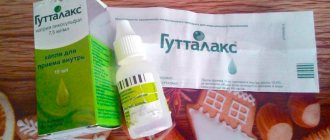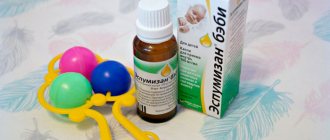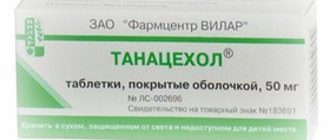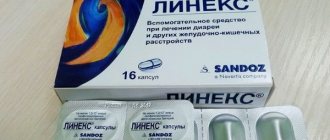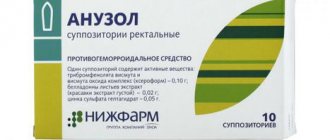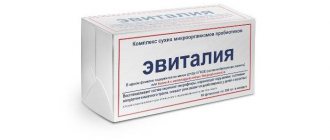Release form, packaging and composition of the drug Clinical-pharmacological group Pharmaco-therapeutic group Pharmacological action Indications for use Method of administration and doses Side effects Contraindications for use Use in children Special instructions Drug interactions
Registration Certificate Holder:
Teva Pharmaceutical Industries, Ltd. (Israel)
ATX Code:
A06AB08
Active substance:
sodium picosulfate
Dosage form:
Laxigal
| The drug is approved for use as an over-the-counter product | Laxigal | Drops for oral administration reg. No.: P N012803/01 dated 11/30/11 - Indefinitely |
Release form, packaging and composition of the drug Laxigal
Drops for oral administration
in the form of a clear liquid, colorless or with a faint yellow-brownish tint.
| 1 ml | |
| sodium picosulfate | 7.5 mg |
Excipients
: liquid sorbitol 70% non-crystallized - 680 mg, sodium ethyl parahydroxybenzoate - 0.66 mg, hydrochloric acid 35% - qs, purified water - up to 1 ml.
10 ml - brown glass dropper bottle (1) - cardboard packs. 25 ml - brown glass dropper bottle (1) - cardboard packs.
Instructions for use
The drug Laxigal is prescribed for problems with intestinal motility. The peculiarity of this laxative is its irritating effect, the scope of which is limited to the nerve endings in the intestinal lumen.
This is what causes it to contract in an enhanced manner, leading to the rapid movement of contents into the lower part of the colon. At the same time, the absorption of the liquid contained in the chyme slows down.
Despite the lack of systemic effects on the body, the laxative Laxigal is not recommended to be taken without consulting a doctor.
The drug may cause atypical reactions from internal organs and may also interact with other medications.
Indications for use
The indication for taking Laxigal is the inability to empty the intestines on your own.
Most often this is caused by a pronounced weakening of peristalsis, pain during defecation..
Thus, the drug is indicated for:
- constipation caused by intestinal atony;
- hemorrhoids;
- proctitis;
- anal fissures;
- preparation for surgical and diagnostic procedures.
Mode of application
It is recommended to use the product with a small amount of water, which shortens the time the drug enters the intestines directly. The laxative dosage at the initial stage is:
- children from 4 to 10 years old - from 6 to 12 drops per dose;
- children over 10 years old and adults – from 12 to 24 drops.
The primary point for selecting an individual dose of the drug is the patient’s build and weight. It is better to start treating constipation with a minimum dose. If there is no effect or a low level of relaxation, the number of drops per dose is increased gradually - 3-4 drops every day until the expected effect occurs. In case of severe softening of the stool (diarrhea), the dosage is reduced by 3-4 drops per day.
The effect of taking the drug occurs after 10-12 hours, so it is recommended to drink it in the evening so that bowel movements occur after waking up.
Release form and composition
The drug is available in liquid form. Drops are bottled in dark glass bottles equipped with a dropper device, 10 or 25 ml in volume. The liquid does not have a distinct odor or taste; it is transparent in appearance, colored slightly yellowish, sometimes with a slight brown tint.
The main active ingredient of Laxigal is the compound sodium picosulfate (7.5 mg/1 ml of product). This substance reacts with intestinal microflora and releases metabolites that affect nerve endings in the intestinal lumen.
To improve the taste of the drops , preserve them for a long time and give them a syrupy structure, additional components are included in the preparation: water, non-crystallizing sorbitol, hydrochloric acid and complex sodium compounds.
Drug interactions
When taken simultaneously with other drugs, Laxigal may change the degree of its or their effectiveness, or cause increased side or toxic effects. Thus, when taken with drugs that contain cardiac glycosides, the toxic effect of the latter may be enhanced.
antibiotics reduce the effectiveness of laxatives, while diuretics and glucocorticosteroids, on the contrary, enhance it.
All these points must be taken into account when prescribing the drug. A prerequisite is to inform the doctor of information about all medications that the patient will take during the same period with Laxigal.
Price
The cost of the drug Laxigal in most pharmacies in Russia and Ukraine fluctuates with a difference of several tens of rubles/hryvnia, however, it belongs to the category of inexpensive laxatives.
Cost in Russia
In Russian pharmacies, Laxigal costs on average about 185 rubles for a 10 ml bottle, while 25 ml of the drug costs about 270 rubles.
Price in Ukraine
In Ukrainian pharmacies, the cost of one package of Laxigal 10 ml costs on average 98 hryvnia, 25 ml - in the range from 140 to 160 hryvnia.
Laxigal
Laxigal (active ingredient - sodium picosulfate) is a laxative that stimulates intestinal motility and is used for constipation of various etiologies. Constipation is understood as a disorder of the intestines, manifested by an increase in the time intervals between bowel movements by more than two days compared to the norm or regular incomplete bowel movements. Before prescribing a specific drug, you must first find out the reasons that caused constipation. It often happens that eliminating the cause (if possible) leads to complete normalization of stool. The treatment tactics for constipation are only minimally designed for pharmacological assistance and rely to a greater extent on a number of non-drug corrective measures. For example, eliminating dietary errors. For constipation, it is recommended to eat foods rich in fiber (oatmeal, bran, wholemeal bread, cabbage, leafy vegetables, beets, plums, apples). One of the mandatory measures in such cases is to reduce the consumption of animal fats. It is recommended to consume the liquid in large quantities: at least 8 glasses per day. The complex of “anti-constipation” measures also includes increasing physical activity and taking vitamin and mineral complexes. The act of defecation itself should take place in a calm environment, without haste or distractions. If measures to optimize the motor-evacuation function of the intestine using non-drug methods are ineffective, laxatives are included in the treatment of constipation. Success on this path is determined by the accuracy of identifying and the degree of elimination of the causes of constipation, the responsibility of the patient’s behavior (after all, he will have to significantly adjust his usual lifestyle) and the doctor’s willingness to individually approach each specific clinical case. Disorders of large intestinal motility can develop according to the hypertonic and atonic type (with an increase or decrease in smooth muscle tone, respectively).
The focus of therapeutic measures is determined by the predominance of one or another type of disorder of the motor function of the large intestine. The pharmacological effect of laxatives is based on mechanical or chemical stimulation of receptors in the intestinal wall. There are three groups of laxatives: drugs that stimulate motor function; agents that change the consistency of feces, and drugs that “booster” intestinal contents. Laxigal can be classified into both the first and third groups: being a contact laxative, the drug enhances intestinal motility and at the same time it increases the volume of intestinal contents, because inhibits the absorption of water from the digestive tract. Strictly speaking, laxigal is a prodrug, because is activated after entering the intestine as a result of hydrolysis under the influence of intestinal microflora. The drug has a direct stimulating effect on the nerve structures located in the intestinal mucosa. This accelerates the movement of intestinal contents and reduces the absorption of water and electrolytes. Laxigal begins to act 10-12 hours after entering the body. It is not absorbed from the gastrointestinal tract and does not undergo enterohepatic circulation. The drug is available in drops for oral administration. Before use, the drops are diluted with a small amount of water. Adults and children aged 10 years and older are prescribed 12-24 drops. Children from 4 to 10 years old - 6-12 drops. Depending on the therapeutic response, the dose of the drug may vary either up or down. The maximum duration of taking Laxigal as part of self-medication (without consulting a doctor) is no more than 10 days. For children, the drug can only be prescribed by a doctor. While taking Laxigal, there is an increase in sensitivity to digoxin and other drugs of the cardiac glycoside group. Concomitant use of glucocorticosteroids and diuretics with Laxigal potentiates the risk of water-mineral imbalance.
Side effects
Side effects when taking Laxigal appear infrequently and are sporadic. Thus, during a course or single dose, the following may occur:
- diarrhea (can be eliminated by reducing the dosage);
- spasmodic pain in the abdomen (it is recommended to take an antispasmodic after taking a laxative);
- violation of water-salt metabolism.
In the latter case, symptoms can be mild or pronounced - from dizziness to a critical decrease in blood pressure, fainting and convulsive contractions of the muscles of the lower extremities.
Experts note that side effects are especially pronounced when recommended doses are exceeded or when they are selected incorrectly (when treatment is started with the maximum allowable dosage).
Contraindications
The drug is contraindicated in cases of complete or partial intestinal obstruction resulting from the formation of a tumor in its lumen, intestinal spasm, strangulation and torsion of its loops (strangulated hernia and the so-called volvulus).
Another contraindication is considered to be inflammation of the intestine in the acute stage, as well as peritonitis.
A laxative should not be prescribed if there are traces of blood in the stool or severe bleeding in the gastrointestinal tract, or if there is pain of unknown origin localized in the abdominal area.
There are also a number of other restrictions not directly related to the digestive organs:
- cystitis;
- metrorrhagia;
- severe dehydration;
- tendency to spasms;
- intolerance to the components of the laxative;
- pregnancy;
- childhood.
During pregnancy
The laxative Laxigal is not recommended for use during pregnancy, especially in the first trimester. In the second and third cases, it is possible to use it, but only under the supervision of a specialist in a hospital.
Lactation also requires caution when prescribing Laxigal. While taking it, it is recommended to temporarily stop breastfeeding.
Analogs
Structural analogues (synonyms) of the laxative Laxigal are drugs that contain sodium picosulfate in the same dosage, namely:
- Regulax Picosulfate;
- Slabicap;
- Weak.
Herbal products have a similar effect:
- Senade;
- Alfit-5;
- Phytolax;
- Duphalac.
The components they contain also irritate the intestines, causing increased peristalsis and rapid bowel movements.
Video on the topic: How not to treat hemorrhoids
Storage conditions and periods
To store Laxigal, you must choose places that children cannot reach. It is also recommended to pay attention to the lighting and temperature in the room.
There should be no sunlight (direct), and the temperature should be maintained at 10-25 degrees.
If these standards are observed, the drug does not lose its properties for 36 months from the date of production.
It is strictly prohibited to take a laxative that has expired. The recommended method of disposal is with municipal solid waste in closed packaging.

